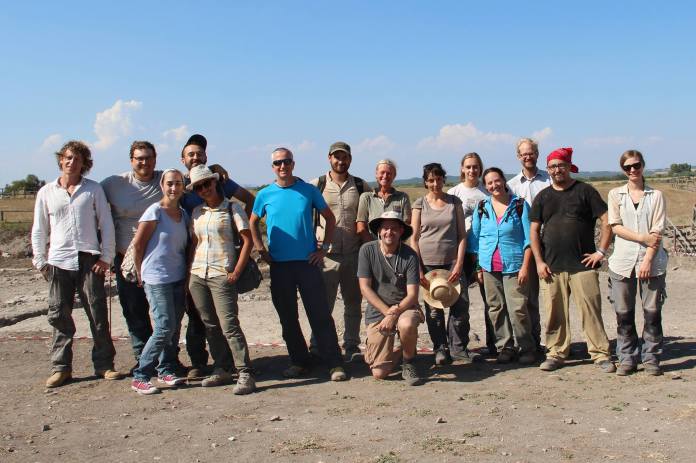Having pursued historical studies into classical antiquity for the better part of the last decade, I’ve lately found myself increasingly preoccupied with the Etruscans, a people steeped in legend, who once exerted dominion over Rome itself (otherwise my main field of interest) and whose culture is still shrouded in mystery. Most, if not all we know about the Etruscans has been are revealed by studying their graves and vast necropoleis, or Cities of the the Dead. No written accounts survive and they seems to have been almost completely ‘swallowed up’ by Roman civilization, in whose debt they unquestionably were, the Romans wouldn’t necessarlily have stressed the link to the Etruscans, instead they traced their origins back to Troy and frowned upon the excesses and luxuriant habits of the Obesus Etruscus, their former enemies and onetime rulers who often would depict themselves resting in fond embraces, feasting and enjoying the good life – not seldomly with bloated bellies – in stone on top their sarcophagi.
I’ve ventured into Etruria a few times now and visited former Etruscan cities such as Tarquinia, Cerveteri (it’s connected port Pyrgi), Orvieto, and Etruscan archeological sites managed by the Swedish Institute nearby Rome such as San Giovenale and Acquarossa. Most recently I had an fantastic opportunity to spend two weeks at Vulci3000, an archeological project and currently ongoing dig at a Roman Forum. The trench is located right next to one of the main roads, the decumanus, and on its opposite side lies the Tempio Grande, an Etruscan Temple base reused during Roman times, beside a large already excavated Roman Villa. The Roman Forum was built on top of the city center of Velch, the Etruscan name of what was once an important Etruscan city, subsequently conquered in 280 BCE and after being romanized known as Vulci. It’s location on a high plateu has today mostly a few medieval structures visible above ground, a smallish castle and a charming brigde and a damaged church ruin, apart from the concentration of Roman and Etruscan ruins appearing near and around the area of the Forum. Rural farmlands now cover mostly all of the ancient Etruscan and Roman layers and the site fuctions as an archeological park open to the public just a few kilometers inland from the coast and the nearby town of Montalto di Castro.
 June 27:th 2017
June 27:th 2017
Pictured above is part of the Vulci3000 team. The project is led by Dr Maurizio Forte (centre, in blue shirt), professor at Duke University, and on his left Dr Elisa Biancifiori from Sapienza University who directs the daily excavations. The picture was taken by Todd Berreth (seated), assistant Professor at North Carolina State University ,who is currently developing a “smart trowel”, a multi-sensor tool for data recording to help archeologists record information in new ways (and I’m on the far left here).
Vulci3000 is a collborative project between the universities of Sorbonne, Wisconsin-Milwaukee, Ca’ Forscari, Padova, Federico II and Gothenburg and was an incredible experience. I’ll have reason to return (hopefully very soon) to what was discovered during my time at the dig..! Good times were had and a truly great experince! Find out more current developments and news about Vulci3000 here: https://www.facebook.com/Vulci3000
The time has come to revisit what I’ve seen so far in Etruria so the first film includes visits to Sutri and Cerveteri, with the aim to then continue along “The Road into Etruria” with other cities and sites. The first stop, Sutri, was besieged by the Etruscans in 311–310 BCE, but not taken. With Nepi and ten other Latin colonies it refused further help in the Second Punic War in 209 BCE. Its importance as a fortress explains, according to Festus, the proverb Sutrium ire, of one who goes on important business, as it occurs in Plautus. The Amphitheatre has the unique feature of being almost entirely cut out of the Tufa rock. Sutri is mentioned in the war of 41 BCE, and received a colony of veterans under the triumviri (Colonia coniuncta lulia Sutrina). Inscriptions show that it was a place of some importance under the Roman Empire, and it is mentioned as occupied by the Lombards.
Cerveteri is famous for the site of the ancient Etruscan city which was one of the most important Etruscan cntres with an area more than 15 times larger than today’s town. Etruscan Caere was previously located nearby the present location in the vicinity of the Etruscan necropolis of Banditaccia, with its about 1000 graves making it the largest ancient necropol anywhere in the Mediterranean (also featured in the film).
Music in the film is “Into the Night” by Ledjelly
Journey Thru History, Perseus Records ® 2017